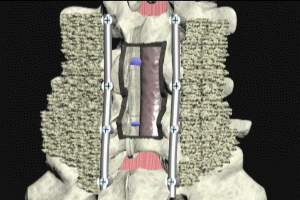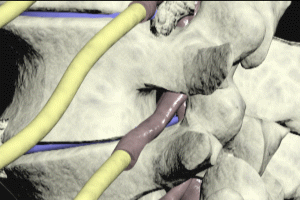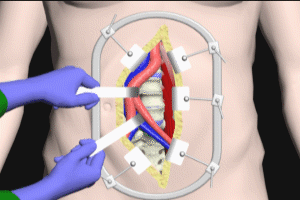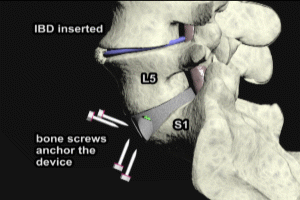Intertransverse Fusion Lumbar Spine (ALIF Part 4) ORT074
Intertransverse Fusion Lumbar Spine Transcript
Intertransverse Fusion Lumbar Spine
This is Dr. Cal Shipley presenting a comparison of the ALIF anterior lumbar interbody fusion procedure and intertransverse fusion for the treatment of multilevel degenerative disc disease.
Multilevel Spinal Disease
For this presentation, I’m going to be using the same spinal model as in Parts 1 and 3 of my ALIF review.
There is multilevel disease with collapse of the L3-4 and L4-5 discs and partial collapse of the L5-S1 disk accompanied by spinal nerve root compression due to narrowing of neural foraminae, and compression of the cauda equina as a result of disc herniation at the L3-4, L4-5 level, as well as compromise of the spinal canal by bone spurs.
In addition, in this example, the patient just had a previously performed right-sided hemilaminectomy at the L3-4, L4-5 levels to treat disease at an earlier stage.
Intertransverse Fusion versus ALIF
The intertransverse fusion or ITF procedure has one major advantage over the ALIF (Anterior Lumbar Interbody Fusion.) It uses a strictly posterior approach to access the spine. This eliminates the need to enter the abdomen and reposition the abdominal contents as is required in the ALIF procedure. This in turn eliminates the possibility of complications associated with manipulation of the abdominal contents such as intestinal or vascular injury or abdominal infection.
In general, this also reduces the length of the operative procedure and the duration of general anesthesia. With this in mind, why would an individual with degenerative disc disease of the lumbar spine want to consider the ALIF procedure at all? Let’s take a closer look at the intertransverse fusion procedure and see if we can shed some light on this question.
The intertransverse fusion procedure is ideally suited to convert the previous partial hemilaminectomy to a full laminectomy which results in decompression of the cauda equina.
So far so good, but in an individual with multilevel disc disease and a history of a previous hemilaminectomy, here is where the posterior only approach begins to run into some limitations.
Adhesions with Previous Spinal Surgery
As mentioned in part 3 of this series, the previously performed hemilaminectomy causes adhesions to form between the cauda equina and the disc spaces. The scarring makes it both difficult and dangerous to use a posterior approach when performing spinal surgery to treat multilevel degenerative disc disease. The surgeon’s ability to see the cauda equina clearly and keep it out of harm’s way is significantly impaired and the risk of neurological injury too great. In these circumstances, the anterior spinal approach is much preferred for the placement of interbody devices.
This type of adhesion formation in and around the spinal canal commonly occurs, not only with laminectomy, but also with virtually any form of previously performed spinal surgery used to treat disc disease. How does the intertransverse fusion attempt to get around these limitations in the treatment of multilevel disk disease?
Hardware Placement
Once the laminectomy has been completed, supporting struts are attached to the vertebra on either side by the same process detailed in part 3 of this series. Next, a grafting procedure involving the transverse processes of the vertebrae is performed. Graft material is packed between the transverse processes on either side.
Intertransverse Fusion Limitations
Neural Foramena and Spinal Stability
There is no relief for neural foramen narrowing with the intertransverse fusion. Contrast that with the ALIF procedure where the placement of interbody devices restores the spinal architecture and opens up neural foramen narrowed by previous disc collapse.
In the absence of interbody devices, there is no compression of the load-bearing areas of the L3 and S1 vertebrae. In the ALIF, interbody devices provide compression and stability along load-bearing areas of the vertebrae with resistance to shifting. Without compression, the grafted vertebrae in the intertransverse fusion procedure are subject to shifting. Repeated shifting of the vertebrae may eventually result in post-operative graft failure.
Pedical Erosion
In addition, vertebral shifting may apply stress to the pedicle screws used to attach struts resulting in erosion of vertebral bone. If this process continues unchecked, the screws may rupture through the pedicle.
Viewing the vertebra from above gives us a better view as the screw ruptures through the pedicle. Once rupture has occurred, the pedicle cannot be used for re-repair. Needless to say, this process may occur bilaterally.
Summary
In summary, while the intertransverse fusion procedure avoids surgical entry into the abdomen and the subsequent manipulation of organs required to expose the spine, and while it typically requires a shorter duration of general anesthesia for the patient compared to ALIF, in patients who have had a previous history of spinal surgery, the formation of scar tissue and adhesions makes safe placement of interbody devices from the posterior only approach impossible.
By contrast, when the ALIF procedure is performed in a patient with a previous history of spinal surgery, interbody devices may be safely inserted at multiple levels with relief of neural foramen spinal nerve root compression and, perhaps of greatest importance, the ALIF procedure can achieve excellent long-term stability of the lumbar spine.
Finally, it’s important to note that in skilled hands, the abdominal surgery used to expose the spine in the ALIF procedure has a very low rate of complications. You can find a detailed review of the abdominal retroperitoneal spinal exposure procedure as well as the anterior lumbar interbody fusion procedure itself in parts 2 and 3 of this series.
Cal Shipley, M.D. copyright 2020




